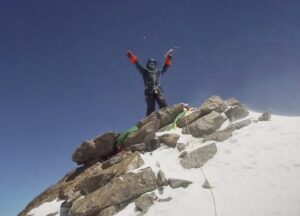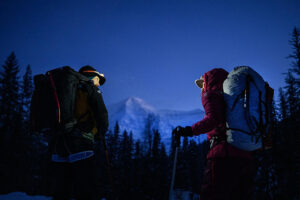In November 2019, Swiss alpinists Lukas Hinterberger, Nicolas Hojac, and Stephan Siegrist set out to forge new routes in a remote and little-visited range. Their shared quest brought the three halfway across the world to the central section of the North Patagonian Icefield.

From left to right: Nicolas Hojac, Stephan Siegrist, Lukas Hinterberger. Photo: L. Hinterberger
In their five weeks abroad, the trio pursued the second-ever ascent of Cerro Largo (2,799m) and the first ascent of the northeast face of Cerro Cachet (2,632m). Both peaks tower above Chile’s immense Nef Glacier.
Base camp and bad weather

The Swiss expedition’s base camp in the Chilean forest. Photo: L. Hinterberger
The location of the team’s base camp was so untouched by civilization as to require access via boat and horseback.
On arriving in the heart of a Chilean forest, they set to work building a shelter. Felling timber, pitching walls, and lining their hut with moss filled the trio’s first day. “We were still tired after the journey,” Hinterberger recalled. “It would have been too much to take on Cerro Largo straight away.”

The Swiss expedition team sets out for an exploratory mission to the Nef Glacier. Photo: Mammut
The following morning, they embarked on an hours-long approach to the foot of the Nef Glacier. There they felt out the terrain and begin stashing equipment for their eventual summit attempt.
Then a block of unfavorable weather moved in. “In the mountains, the precipitation amounted to some two metres of fresh snow,” explained Hojac. “In avalanche terms, this is a relatively critical volume.”
Reprieve from the flurries finally came on day nine, and all three men set out eagerly for Cerro Largo. Knowing that avalanche potential could hold them off the summit push, they nonetheless skinned toward the headwall with great determination.
Cerro Largo — second ascent, northeast ridge

One Swiss team member on the second ascent of Cerro Largo’s northeast ridge. Photo: Mammut
The hike to Cerro Largo was long, and the team arrived at its base later than they’d hoped. But they were determined to cut their teeth on the peak’s northeast ridge.
And so it began.
“For Nicolas and me in particular, it was very special to climb on Patagonian rime ice for the first time,” said Hinterberger. “We had a lot of fun.”

The team heads for Cerro Largo’s summit via the northeast ridge. Photo: Mammut
And in short order, around 6:30 pm local time on November 22, all three mountaineers found themselves on top of Cerro Largo. It was a celebratory moment but not nearly the challenge they were after. Siegrist later described it as “similar to a demanding ski tour, but with a short passage of ice at the very end.”
They’d spend the next seven days waiting out more unsavory weather and preparing for something more gripping.
“One mountain had caught our eye when we were setting up the equipment store,” Siegrist reported. “A mighty, beautiful mountain looming up slightly out of the valley.” It was Cerro Cachet.
Cerro Cachet – first ascent, northeast face

Cerro Cachet. Photo: Mammut
Although slightly lower in elevation than Cerro Largo, Cachet’s faces are notably steeper and more dangerous.
The cap of Cachet wasn’t wholly untouched. Two expeditions before theirs had summited the peak. But as noted in Siegrist’s trip report, the prior ascensionists had gone “via the fairly easy terrain on the side facing the inland ice.”
But that was not what the Swiss climbers had come to Chile for. They yearned to establish an entirely new and more technically demanding route up Cerro Cachet. To do so, they would have to scout quickly and adeptly.
“Cachet now looked considerably larger and more impressive than we’d realized while looking through binoculars. There’s one thing you basically never have on the mountain in Patagonia: time. In our case, it was a mere day. The weather forecast predicts wind speeds of 100 kph for the following morning,” Siegrist recalled.
Heavy snow and precarious cornices sheathed much of the mountain, and base camp lay four hours off in the distance.

The headwall of Cerro Cachet. Photo: Mammut
After a morning of scaling and rappelling over the massif, they found what they’d been seeking. “[A] 600m vertical wall rises into the blue Patagonian sky before us,” wrote Siegrist. “Uncharted climbing territory. One of the rare white spots in the vertical world that mean about as much to alpinists as the big nuggets did [to the] the gold diggers in the 19th century.”

A climber leads a pitch on Cerro Cachet. Photo: Mammut/YouTube
And so began the Swiss expedition team’s 10-hour summit push up Cerro Cachet’s 600m virgin wall. Establishing the mixed-terrain route meant overcoming graduated pitches of up to M7+ climbing.
Finally, late in the afternoon of December 3, Hinterberger, Hojac, and Siegrist reached the summit. They named their proud line Homenaje a los Amigos Perdidos, in memory of fallen alpinists David Lama, Ueli Steck, and Julian Zanke.

The Swiss expedition team’s route, ‘Homenaje a Los Amigos Perdidos,’ M7+ on Cerro Cachet. Photo: S. Siegrist/AAC
Footnotes
See the 2019 expedition in full through this brief but thorough documentary by Mammut.
For additional route information, refer to the team’s AAC-sanctioned report, Cerro Cachet, Northeast Face, Homenaje a Los Amigos Perdidos, and Hinterberger’s PlanetMountain report.
Runtime: 13.5 minutes





